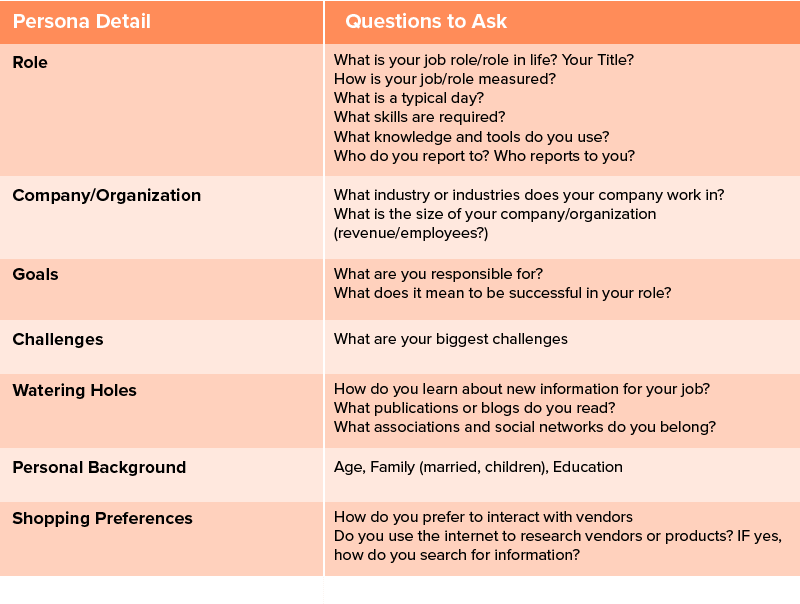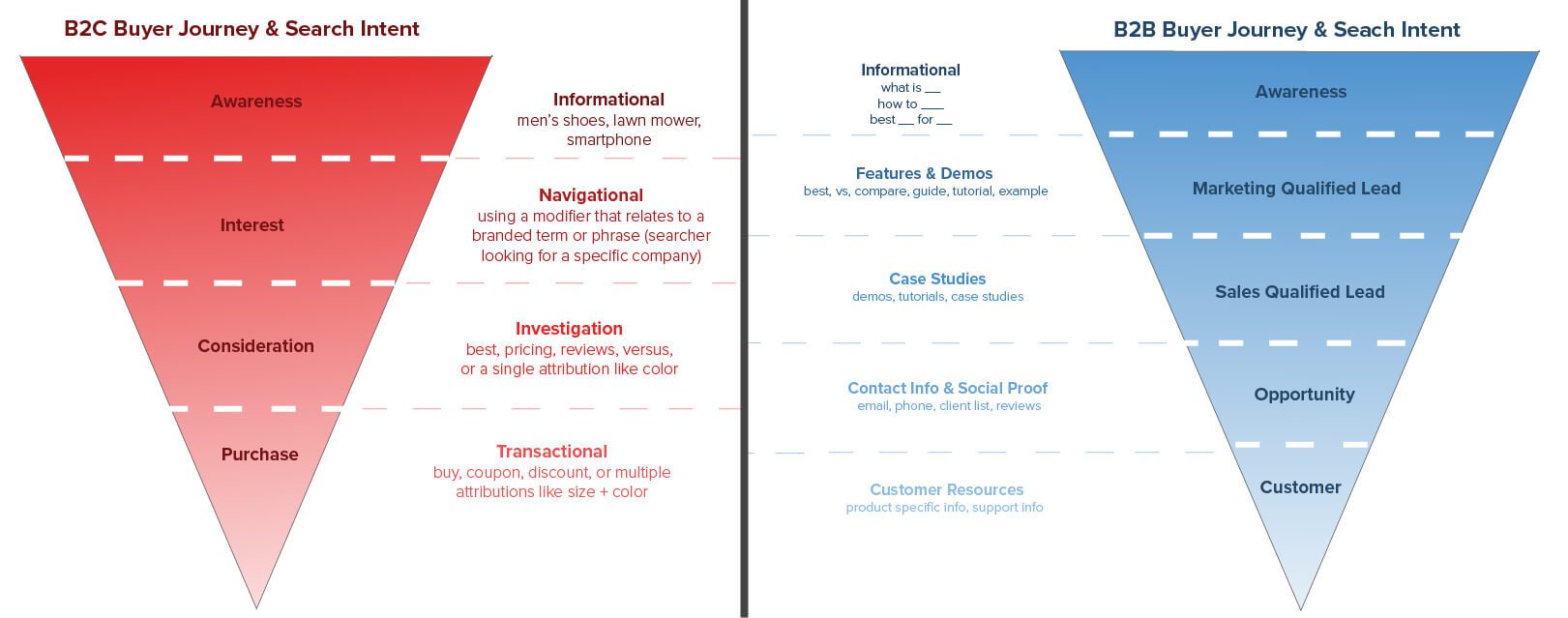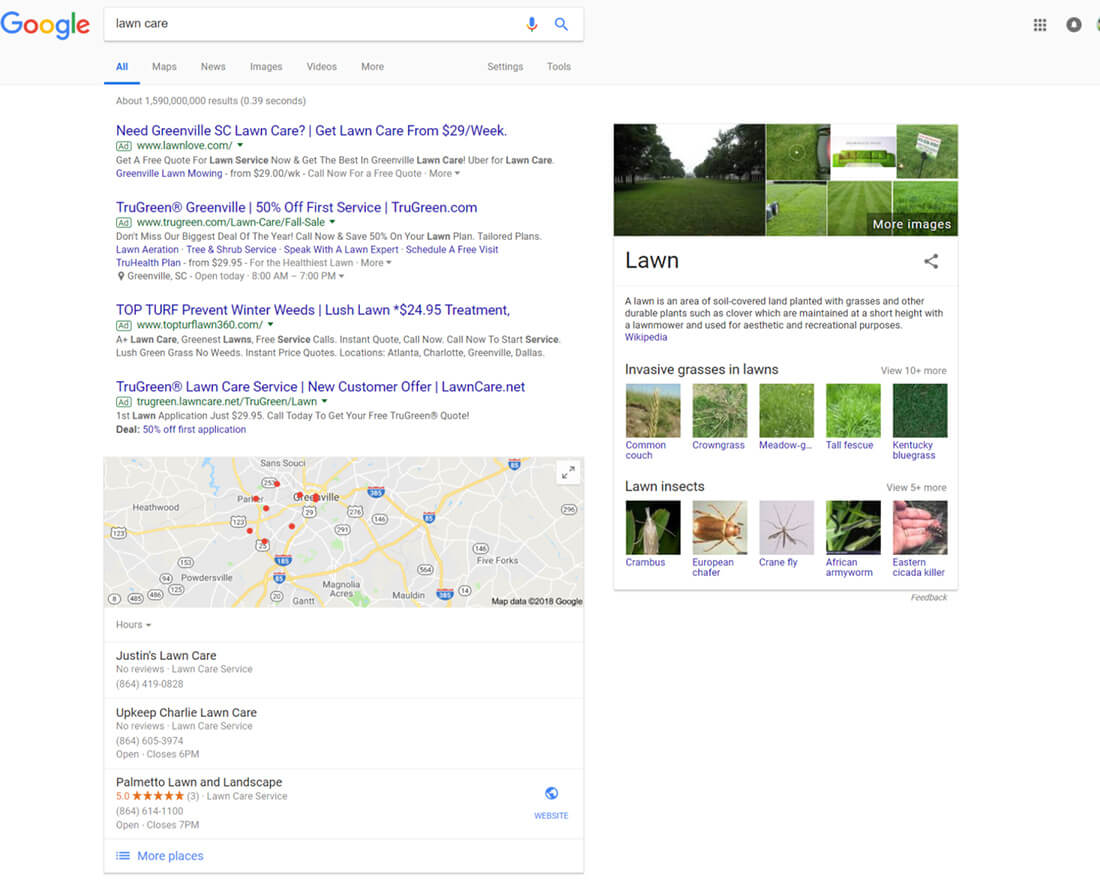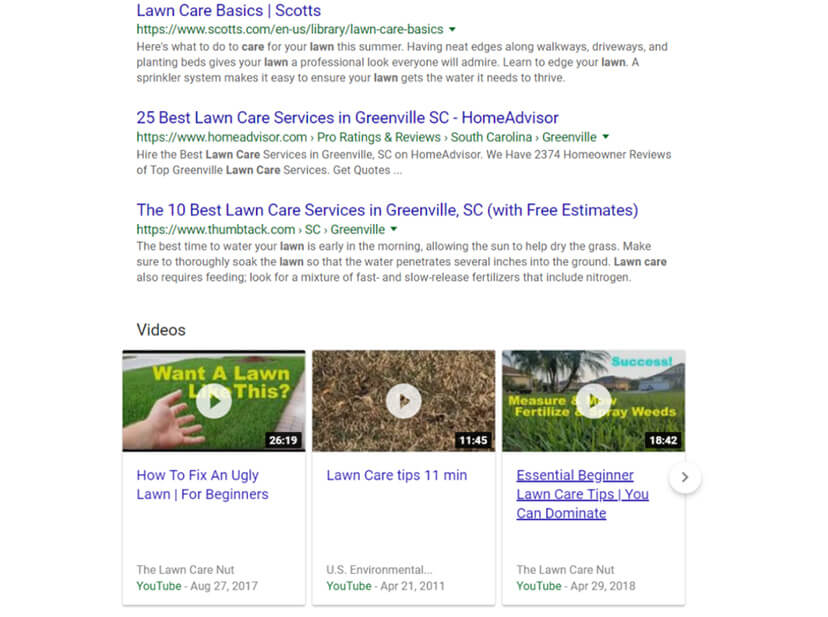You no doubt know what a blog is. It seems that everyone has a blog these days. But blogging about your family vacations is way different than blogging for your business. Especially if you’re a B2B business.
Blogs are a vital piece to your marketing puzzle that should not be ignored. Understanding how that piece will work with all the other marketing pieces, allows you to create a holistic approach to driving in traffic, leads, and boosting your credibility.
Why You Should Be Blogging
Blogging should not be a self-serving way to promote your good and services. If your blogs are centered around what your products can do, how your company operates, or what makes your product different, then we’re glad you here because a ‘me’ centered blog is not going to win over the hearts and minds of your customers.
So what should blogging be? Blogging should be about your customers, their journey, and their pain point.
Blog Writing Based on The Buyer’s Journey
As purchasers, shoppers, and first class consumers, our buying process has changed and turned us into researching machines.
Before we step foot in a store we want to know exactly what our problem is, several ways to fix that problem, the most popular way to fix that problem, and the best tool or service for fixing it.
We no longer go to stores or call a business asking these questions.
Which means as a business, you need to create content that will answer those questions for consumers if you want to be a part of our buying process before we’ve made our purchasing decision.
Writing based on your buyer’s journey means three things: you have to understand who your customers are, what buying journey they take, and what questions they ask along the way.
Understanding Your Buyers
Creating a buyer persona is a good exercise to do for new businesses but also important for those well-established companies. Regardless of how long you’ve been in business, going through this exercise will keep you in-line with who you want to be serving and allow you to analyze your audience.
Creating a buyer persona will help you answer:
- How well do your buyers understand the service/product you’re writing about?
- Are they a decision maker at their respective organization?
- What kind of tone will resonate with them?
A comprehensive understanding of your audience lays the foundation for a great blog post. There are a handful of tools out there to help you get started on creating a buyer persona but HubSpot has a simple chart and detailed blog post to get you started.

Create Blog Content That Corresponds with Your Buyer’s Journey
The key to creating relevant resources for your consumers is to match up their research needs with their place in the buying journey. The buyer’s journey, for those who are unfamiliar, are a set of stages each shopper (B2B and B2C) go through before making a purchase.
We’ve written on the buyer’s journey quite a bit. Check out What Does Today’s Buying Process Look Like? And How Search Trends Affect Product Research for more info.
The buyer’s journey for B2B and B2C customers vary slightly.
B2C Buyer’s Journey Stages
Awareness
[icon color=”Accent-Color” size=”regular” icon_size=”” image=”fa-long-arrow-down”]
Interest
[icon color=”Accent-Color” size=”regular” icon_size=”” image=”fa-long-arrow-down”]
Consideration
[icon color=”Accent-Color” size=”regular” icon_size=”” image=”fa-long-arrow-down”]
Purchase
B2B Buyer’s Journey Stages
Awareness
[icon color=”Extra-Color-2″ size=”regular” icon_size=”” image=”fa-long-arrow-down”]
Marketing Qualified Lead
[icon color=”Extra-Color-2″ size=”regular” icon_size=”” image=”fa-long-arrow-down”]
Sales Qualified Lead
[icon color=”Extra-Color-2″ size=”regular” icon_size=”” image=”fa-long-arrow-down”]
Opportunity
[icon color=”Extra-Color-2″ size=”regular” icon_size=”” image=”fa-long-arrow-down”]
Customer
The buyer’s journey can be looked at in three critical stages:
- Awareness: the user is aware that they have a problem but needs to define the nature of that problem. They don’t necessarily know that your product/service is a possible solution to their problem, they just want to know what the problem is and what possible solutions are out there.
- Interest/Qualified Leads: the consumer is aware of possible solutions, including yours, and is trying to decide which is the best. At this stage they want to know why one solution is better than another.
- Consideration/Opportunity: the buyer has decided that the product/service you provide is the right solution, but hasn’t chosen you as a vendor/partner. This is when you want to talk about how your product/service is better than your competitor’s.
Each stage in the journey corresponds with different types of information the consumer is searching for.

Creating resources that your buyer personas will be looking for at each stage will allow you to reach them when they are doing research. You will establish your business as an authority and knowledgeable place for your shoppers to look when they need advice on solving their pain point.
Guidelines for Content Generation that Follows the Buyer’s Journey
The information below provides some great guidelines for what kind of content works well at different stages of the buyer’s journey for both B2B and B2C businesses.
Awareness Stage
Buyers are looking for answers, resources, education, research data, opinions, and insight. They want educational, third party, vendor-neutral content. They conduct “symptoms” research to decide if a problem exists and to more clearly define and name that problem. They establish requirements and identify if it’s a business or personal problem.
- eGuides
- eBooks
- Whitepapers
- Editorial Content
- Analyst Reports
- Tip Sheet
- Checklist
- How-To Video
- Educational Webinar
issue/opportunity type terms
- Troubleshoot
- Issue
- Resolve
- Risks
- Upgrade
- Improve
- Optimize
- Prevent
Interest/Qualified Leads
Consumers are doing heavy research on whether or not your product or service is a good fit for them. They are committed to solving their clearly defined problem and are more focused on solutions and comparisons. They explore all avenues and types of options across industries and determine a viable solution strategy.
- Webcasts
- Solution comparison whitepapers
- Expert/editorial eGuides
- Product webinar
- Sample
- FAQ
- Podcast
- Demo video
- Data sheet
solution type terms
- Solution
- Provider
- Service
- Supplier
- Tool
- Device
- Software
- Appliance
Consideration/Opportunity
Shoppers are figuring out exactly what it would take to become a customer. They are seeking validation in determining their short list and selecting a vendor. They research products/vendors, build a short list, and assess the possible ROI.
- Vendor/product comparisons
- Case studies
- Trial/software downloads
- Virtual trade shows
- Product literature
- Live demo
- Consultation
- Estimate
- Coupon
comparison/review type terms
- Compare
- Versus
- Vs.
- Comparison
- Pros and Cons
- Benchmarks
- Review
Create Resources Not Just Blog Posts
Blogging should be thought of as a way to build a relationship with your audience. Show your knowledge and expertise by writing helpful, relevant blog posts.
Don’t be a Pushy Salesman
It might seem counterintuitive to create blog posts that solve your client’s need without mentioning your product or service. But no one likes a pushy salesman, and offering your prospective clients the chance to educate themselves without reading through a bunch of sales copy will bolster your relationship with them and they will come back to you again when they are ready to move forward in their buying journey.
It is acceptable to produce a white paper or an ebook and ask for an email address before your users can download it. Many buyers will happily give away some personal information if they are given high value content.
Just about everybody and their mothers is blogging these days. There is a lot of noise cluttering the path for your prospective customers. Cut through the clutter by providing clear directions to point them back to the buying path.
Creating Resources Will Save You Time and Money in the Long Run
Aside from not being a pushy salesman, creating holistic resources that cover every aspect of the question you are trying to answer is good for your customers and your SEO efforts.
Resources are “evergreen” content, a term taken from journalism to mean it is relevant year round. Writing a timely post on “Lawn Care Tips for the 4th of July” will give you a small bump in traffic but after the 4th, people won’t find your post relevant anymore. No one wants to be reading outdated advice (even if those tips are good all summer long).
By creating a year-round resource it will naturally drive more traffic to your website. It also means instead of writing a new blog post on the same topic and creating ‘blog bloat’ you can update one blog post each year. This means less work for you and keeps your content relevant for your customers.
How Blogging Affects SEO
Blogging is one of the very best ways to improve your search engine visibility. How? Let’s hop on Julie’s journey.
Julie is a local homeowner who wants to improve her yard. Julie has a lot of questions as she begins this project, so naturally, she turns to Google.
First, she searches “what length should I cut my grass?” A local landscaping business called The Manicured Lawn maintains a very effective blog and they have an article titled “How to Cut Your Grass to the Perfect Length – for Every Grass Type.” This title is so relevant to Julie’s search, Google places it near the top of the results page.
Because it’s so relevant to her question, she clicks! Julie reads every word of The Manicured Lawn’s blog post. She spends over 5 minutes on the website reading the post.
While on the site, she explores a little further and finds additional helpful information. Before closing her browser and heading outside, Julie found the post so valuable, she posts a link on Facebook for her friends. A handful of Julie’s friends read the post and a couple of them share it too.
What does this have to do with SEO?
- Answering your audience’s questions helps you rank well for the keywords they’re already searching for.
- Blogs get users to your site. According to Hubspot, companies who blogged 11 times per month had 3x the amount of traffic as those who blogged 0-1 times per month.
- If users spend significant time on your site, Google recognizes this engagement, notes your site as valuable, and rewards you.
- If your blogs are really valuable, readers will share them, earning your site backlinks and increasing your domain authority. Many SEO experts believe links are the most important factor in your search engine ranking.
How to Add Keywords Into Your Blog
If you follow your buyer’s journey and create content for each stage you will already be setup for keyword success. By asking “what questions are my customers currently asking me and my sales team” you’ve already identified a handful of relevant keywords.
Keywords are the words people use to search for a product or service. They can range from broad (lawn service) to very specific (hedge trimming for commercial properties).
Depending on your target audience and their buying journey you will want to stray away from very broad keywords when it comes to blogging. You might provide general “lawn care” but so do a dozen other businesses within your city. And it isn’t just your competitors that your fighting for keywords with. Blogs are often the best place to target those specific keywords with well-targeted posts.
Google and Search Intent
We’ve written extensively on search intent for local businesses if you want to take a deep dive, but generally, search engines try to guess what the intent behind a search is.
For a search on ‘lawn care’ Google returns several types of results:
The first half of the page is filled with ads and a “local pack” of business offering lawn care services. The right side of the screen contains a “knowledge panel” giving general information about what a ‘lawn’ is.

Here Google is unsure of your exact intent because the keyword “lawn care” is so broad. If you keep scrolling down the page you will see:

Google still can’t decide if you are searching “lawn care” for education and learning purposes or to find a lawn care service provider. If you write blog content and resources with “lawn care” as your target keyword, it will be near impossible for you to rank on the first page.
You want to make sure your keyword lines up with what Google thinks your user’s intent is. By narrowing down your target keyword into a specific aspect of your service, like “best lawn care practices for Bermuda grass,” search engines can better line up your content with your buyer’s intent. And you’ll have an easier chance of ranking near the top of the search results.
Don’t Keyword Stuff Your Blogs
Keyword stuffing is where you use one keyword dozens of times throughout your article. Not only do search engines dock you for it, but it’s also not at all user-friendly. And you are blogging for your human audience—not search engines.
Search engines have also gotten much smarter over the last few years. They now look for contextual words to make sure the entire article is about your main keyword.
If you are writing on the best lawn care practices for Bermuda grass but spend your entire time talking about common outdoor pests in the Southern US, well, search engines won’t think your blog is relevant to the original headline, therefore not showing your article when someone searches for information on Bermuda grass. No matter how many times you use the word “Bermuda grass.”
Using Links in Your Blog
There are two types of links to use in a blog; outbound links and internal links.
Outbound links are links to third party websites. Consider these links like citing your sources. When you come across helpful, relevant information that can add insights for your readers, don’t be shy in adding these facts and links back to the original website.
There is a school of thought that says sending people off your website is a big no-no. But, when you find a credible, authoritative website having a link from your article can actually help your article rank better.
These links help search engines see what content is related to each other, and it helps your readers become better informed. Which, is one of the main goals of blogging.
Inbound links are links that point to other pages on your website. Most often, this will be a link to another blog post to help fill in the gaps for your readers. If you’ve notice, we’ve tossed in a few links back to other blog posts in this article. Manual interlinking is best, but you can use the Link Whisper WordPress plugin to automate internal linking to a great extent.
You’ll also notice none of those links are back to our service or contact page. Readers don’t want to be forced onto your services. Remember your goal: educate, educate, educate.
How to Organize Your Blog
Readability and scannability are important when it comes to blogs. We have short attention spans, and if we can’t quickly find the nugget of information we are looking for, we will leave.
This means writing clear headlines, subheadlines, using bullet lists and graphics where possible. It also means writing short paragraphs.
There is nothing more daunting than opening up an article and seeing half page blocks of text. Especially on a smartphone.
A Word on Blog Titles
Don’t spend hours crafting a great resource for your customers only to give it a vague or irrelevant title. Your title should reflect the quality of your post, incorporate your focus keyword, and be compelling enough to draw users in. It’s a bit of a balancing act.
Coschedule provides a tool called the headline analyzer, where you can plug in a title and it gives you a score based on the types of words you use, the sentiment of the title (positive, negative, neutral), the length, and a handful of other things.
The (free) tool provides a great explanation of how these different things affect the title and how people perceive it. While it isn’t perfect, it can provide some useful feedback when trying to come up with a title.
Some important points to keep in mind when writing a title:
- Incorporate the keyword!
- Use a combination of common, uncommon, emotional, and power words.
- The most effective titles typically come in the form of a question, a how to, or a list. While you can use other methods, these have been shown to work best.
- A positive or negative sentiment typically works better than a neutral sentiment
- Think about how your audience thinks/talks and use that as a guide for the voice you write the title in.
Start the Conversation
Interested in learning more about content blogging and SEO?










